Mostrar el registro sencillo del ítem
dc.contributor.author
Dlamini, J. C.
dc.contributor.author
Cardenas, L. M.
dc.contributor.author
Tesfamariam, E. H.
dc.contributor.author
Dunn, R. M.
dc.contributor.author
Loick, N.
dc.contributor.author
Charteris, A.F.
dc.contributor.author
Cocciaglia, L.
dc.contributor.author
Vangeli, Sebastián

dc.contributor.author
Blackwell, M. S. A.
dc.contributor.author
Upadhayay, H. R.
dc.contributor.author
Hawkins, J. M. B.
dc.contributor.author
Evans, J.
dc.contributor.author
Collins, A. L.
dc.date.available
2023-02-08T17:42:04Z
dc.date.issued
2022-09
dc.identifier.citation
Dlamini, J. C.; Cardenas, L. M.; Tesfamariam, E. H.; Dunn, R. M.; Loick, N.; et al.; Riparian buffer strips influence nitrogen losses as nitrous oxide and leached N from upslope permanent pasture; Elsevier Science; Agriculture, Ecosystems and Environment; 336; 9-2022; 1-14
dc.identifier.issn
0167-8809
dc.identifier.uri
http://hdl.handle.net/11336/187354
dc.description.abstract
Riparian buffer strips can have a significant role in reducing nitrogen (N) transfers from agricultural land to freshwater primarily via denitrification and plant uptake processes, but an unintended trade-off can be elevated nitrous oxide (N2O) production rates. Against this context, our replicated bounded plot scale study investigated N2O emissions from un-grazed ryegrass pasture served by three types of riparian buffer strips with different vegetation, comprising: (i) grass riparian buffer with novel deep-rooting species, (ii) willow (young trees at establishment phase) riparian buffer, and (iii) deciduous woodland (also young trees at establishment phase) riparian buffer. The experimental control was ryegrass pasture with no buffer strip. N2O emissions were measured at the same time as total oxidized N in run-off, and soil and environmental characteristics in the riparian buffer strips and upslope pasture between 2018 and 2019. During most of the sampling days, the no-buffer control treatment showed significantly (P < 0.05) greater N2O fluxes and cumulative N2O emissions compared to the remainder of the treatments. Our results also showed that the grass riparian buffer strip is a sink of N2O equivalent to − 2310.2 g N2O-N ha−1 day−1 (95% confidence interval:−535.5 to 492). Event-based water quality results obtained during storms (12 November 2018 and 11 February 2019) showed that the willow riparian buffer treatment had the highest flow-weighted mean N concentrations (N-FWMC) of 0.041 ± 0.022 and 0.031 ± 0.015 mg N L−1, when compared to the other treatments. Our 9-month experiment therefore, shows that riparian buffer strips with novel deep-rooting grass can therefore potentially address emissions to both water and air. The results imply that over a shorter timeline similar to the current study, the grass riparian buffer strip can potentially address N emission to both air and water, particularly when serving a permanent pasture in similar settings as the current experiment.
dc.format
application/pdf
dc.language.iso
eng
dc.publisher
Elsevier Science

dc.rights
info:eu-repo/semantics/openAccess
dc.rights.uri
https://creativecommons.org/licenses/by/2.5/ar/
dc.subject
DENITRIFICATION
dc.subject
NITROUS OXIDE
dc.subject
PERMANENT PASTURE
dc.subject
RIPARIAN BUFFERS
dc.subject
RUN-OFF N
dc.subject.classification
Ciencias del Suelo

dc.subject.classification
Agricultura, Silvicultura y Pesca

dc.subject.classification
CIENCIAS AGRÍCOLAS

dc.title
Riparian buffer strips influence nitrogen losses as nitrous oxide and leached N from upslope permanent pasture
dc.type
info:eu-repo/semantics/article
dc.type
info:ar-repo/semantics/artículo
dc.type
info:eu-repo/semantics/publishedVersion
dc.date.updated
2023-02-08T15:36:02Z
dc.journal.volume
336
dc.journal.pagination
1-14
dc.journal.pais
Países Bajos

dc.journal.ciudad
Amsterdam
dc.description.fil
Fil: Dlamini, J. C.. University Of The Free State. Faculty Of Natural And Agricultural Sciences.; Sudáfrica
dc.description.fil
Fil: Cardenas, L. M.. Rothamsted Research; Reino Unido
dc.description.fil
Fil: Tesfamariam, E. H.. Universidad de Pretoria; Sudáfrica
dc.description.fil
Fil: Dunn, R. M.. Rothamsted Research; Reino Unido
dc.description.fil
Fil: Loick, N.. Rothamsted Research; Reino Unido
dc.description.fil
Fil: Charteris, A.F.. Rothamsted Research; Reino Unido
dc.description.fil
Fil: Cocciaglia, L.. Universita Di Perugia. Facolta' Di Agraria; Italia
dc.description.fil
Fil: Vangeli, Sebastián. Consejo Nacional de Investigaciones Científicas y Técnicas; Argentina. Universidad de Buenos Aires. Facultad de Agronomía; Argentina
dc.description.fil
Fil: Blackwell, M. S. A.. Rothamsted Research; Reino Unido
dc.description.fil
Fil: Upadhayay, H. R.. Rothamsted Research; Reino Unido
dc.description.fil
Fil: Hawkins, J. M. B.. Rothamsted Research; Reino Unido
dc.description.fil
Fil: Evans, J.. Rothamsted Research; Reino Unido
dc.description.fil
Fil: Collins, A. L.. Rothamsted Research; Reino Unido
dc.journal.title
Agriculture, Ecosystems and Environment

dc.relation.alternativeid
info:eu-repo/semantics/altIdentifier/url/https://www.sciencedirect.com/science/article/pii/S0167880922001803?via%3Dihub
dc.relation.alternativeid
info:eu-repo/semantics/altIdentifier/doi/https://doi.org/10.1016/j.agee.2022.108031
Archivos asociados
